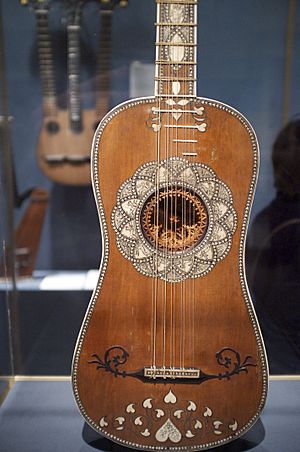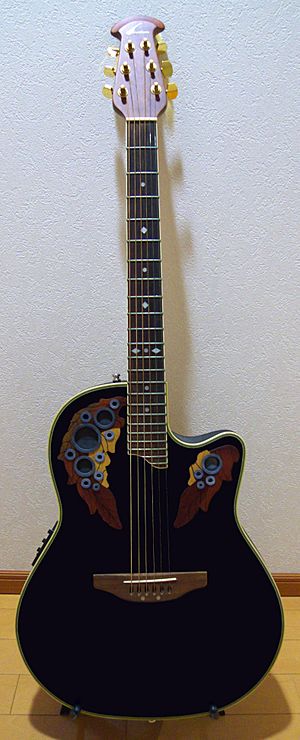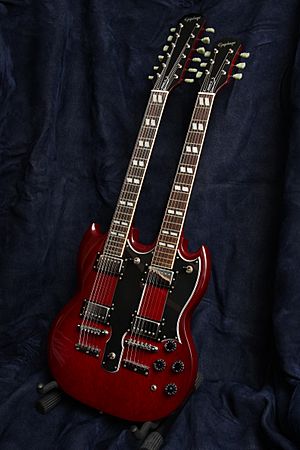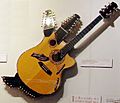Acoustic guitar facts for kids
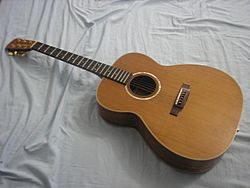
An acoustic guitar
|
|
| Classification | String |
|---|---|
An acoustic guitar is a guitar that produces sound acoustically—by transmitting the vibration of the strings to the air—as opposed to relying on electronic amplification (see Electric guitar). The sound waves from the strings of an acoustic guitar resonate through the guitar's body, creating sound. This typically involves the use of a sound board and a sound box to strengthen the vibrations of the strings.
The main source of sound in an acoustic guitar is the string, which is plucked or strummed with the finger or with a plectrum. The string vibrates at a necessary frequency and also create many harmonics at various different frequencies.
The frequencies produced can depend on string length, mass, and tension. The string causes the soundboard and sound box to vibrate, and as these have their own resonances at certain frequencies, they amplify some string harmonics more strongly than others, hence affecting the timbre produced by the instrument.
History
Gitterns, a small plucked guitar were the first small like guitar instruments created during the Middle Ages with a round back like that of a lute. Guitar like shaped instruments where not seen until the Renaissance era where the body and size began to take a guitar like shape.
The Real production of guitars kicked off in France where the popularity and production first began increasing with large quantities. Spain became the homeland of the guitar but there's very little information on the early makers there, unlike France, where many inventors and artists first began overproducing these instruments and its music.
By the 19th century, coursed strings where evolved into 6 single stringed instruments much like that of the guitar today.
Acoustic properties

The acoustic guitar's soundboard, or top, also has a strong effect on the loudness of the guitar. No amplification actually occurs in this process, because no external energy is added to increase the loudness of the sound (as would be the case with an electronic amplifier).
All the energy is provided by the plucking of the string. But without a soundboard, the string would just "cut" through the air without actually moving it much. The soundboard increases the surface of the vibrating area in a process called mechanical impedance matching. The soundboard can move the air much more easily than the string alone, because it is large and flat. This increases the entire system's energy transfer efficiency, and a much louder sound is emitted.
In addition, the acoustic guitar has a hollow body, and an additional coupling and resonance effect increases the efficiency of energy transmission in lower frequencies.
The different complex air coupling interactions, and the resonant properties of the panels themselves, are a key reason that different guitars have different tonal qualities. The sound is a complex mixture of harmonics that give the guitar its distinctive sound.
Amplification
Classical gut-string guitars had little projection, and so were unable to displace banjos until innovations increased their volume.
Two important innovations were introduced by the American firm, Martin Guitars. First, Martin introduced steel strings. Second, Martin increased the area of the guitar top; the popularity of Martin's larger "dreadnought" body size amongst acoustic performers is related to the greater sound volume produced.
These innovations allowed guitars to compete with and often replace the banjos that had previously dominated jazz bands. The steel-strings increased tension on the neck; for stability, Martin reinforced the neck with a steel truss rod, which became standard in later steel-string guitars.
An acoustic guitar can be amplified by using various types of pickups or microphones. However, amplification of acoustic guitars had many problems with audio feedback.
Types
Historical and modern acoustic guitars are extremely varied in their design and construction, far more so than electric guitars. Some of the most important varieties are the classical guitar (nylon-stringed), steel-string acoustic guitar and lap steel guitar.
Nylon/gut stringed guitars
- Vihuela
- Gittern
- Baroque guitar
- Romantic guitar
- Classical guitar
- Flamenco guitar
- Russian/Gypsy guitar
- Lute
Steel stringed guitars
- Steel-string acoustic guitar, also known as western, folk or country guitar
- Twelve string guitar
- Resonator guitar
- Archtop guitar
- Selmer/Maccaferri (Manouche) guitar
- Battente guitar
- Lap steel guitar
- Lap slide guitar
- Parlor guitar
- Lyre-guitar

Other variants
- Harp guitar
- Pikasso guitar
- Contraguitar
- Acoustic bass guitar
- Banjo guitar
Images for kids
See also
 In Spanish: Guitarra acústica para niños
In Spanish: Guitarra acústica para niños


